When leafing through a cellar list, few diners skip straight to the dessert wines section. Yet, pay this portion of the menu a little attention, and you could uncover a lesser-known gem in the form of Tokaji Aszú. Fans of this most-revered of Hungarian wines rave about its balance: in Aszú, the naturally high acidity in grape varieties such as furmint meets the intense sweetness generated by botrytisation – or ‘noble rot’. This balance empowers the most innovative sommeliers to pair Tokaji Aszús with a wide range of dishes – increasingly savoury as well as sweet – and, indeed, many are embracing a very modern approach to this sweet, old wine. So, while Aszú may not yet be as famous in the US and UK as some of its peers like sauternes, once you know to look out for it, you’ll spot it on many a wine list.
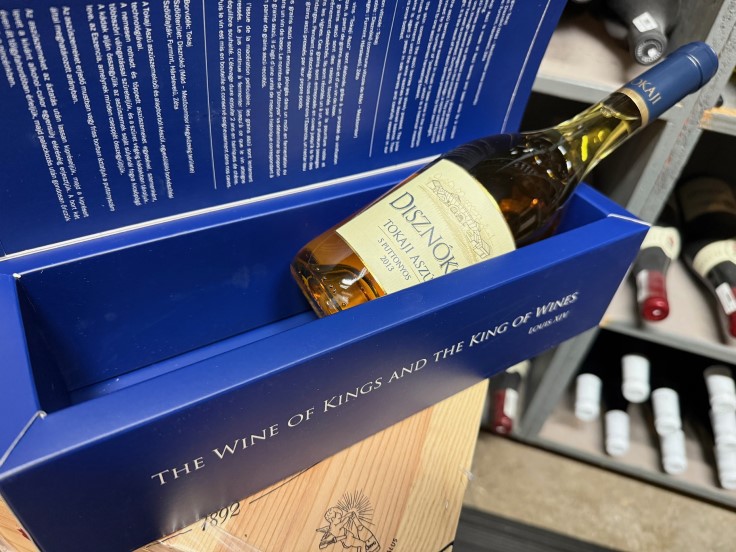
Disznókö Tokaji Aszú 5 Puttonyos in the cellar (© Barolo Grill)
USA
Barolo Grill, Denver, ColoradoEvery year, the team at Barolo Grill take a trip to Europe to ensure they are well-informed when it comes to the restaurant’s flavourful North Italian cuisine and 105-page wine list. This is just one of the reasons this elegant establishment – think white table linens, walls lined with bottles and terracotta-tiled floors – is considered one of Denver’s top restaurants.
Ryan Fletter, the owner and Wine Director of Barolo Grill, is responsible for operating the restaurant’s world-class wine programme, which represents some of the greatest wine estates around the globe, including Royal Tokaji. You’ll find a 2017 5 Puttonyos Aszú within the selection of dessert wines, and the Disznókő 5 Puttonyos 2013 vintage is also available.
So, why Aszú? “I always want to show our guests the greatest examples of the most interesting wines in the world,” he says. “Tokaji Aszú is a sweet and uniquely produced white wine that has so much amazing freshness and acidity.” He also notes that the wine pairs nicely with a broad range of dishes. “We do variations of a beautiful foie gras dish that is enhanced by the rich sweet Aszú wine adding so much balance behind the liver mousse,” he says. “We often introduce seasonal vegetables to the dish like asparagus while adding truffles with toasted brioche and Tokaji gelée to highlight the flavours of the Aszú wine.”
Rolling back the clock, Ryan explains that he was first “electrified and amazed” by the taste of Aszú while working towards his Master Sommelier accreditation, as he sought to push past boundaries and grasp the entire world of wine. “This sweet golden Aszú wine was like honey apricot nectar from the gods!” he says. “It is unlike anything else with its golden apricot colour, saffron and ginger praline nose with tastes ensembled behind amazing freshness and bright acidity.” Another quality that sets Tokaji Aszú apart from its peers is that it can be made to various sweetness levels, Ryan points out, depending on whether you seek a more delicate or robust flavour.
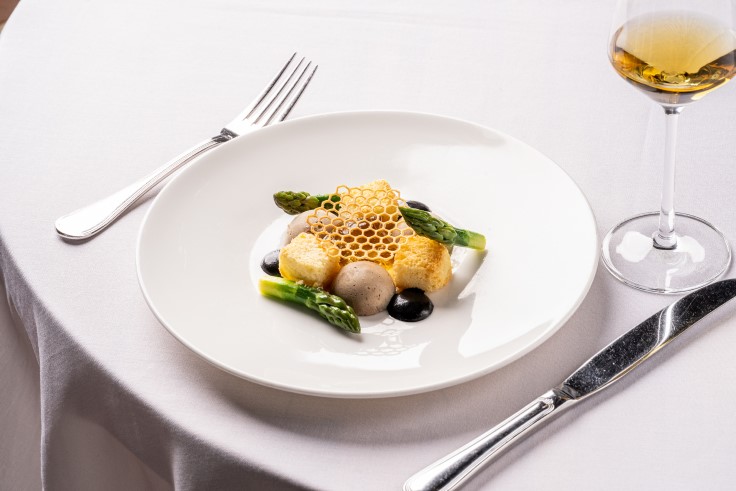
Foie Gras Terrine with Asparagus, Brioche, Black Truffle Purée and Tokaji Gelée, accompanied by Disznoko Tokaji Aszú 5 Puttonyos at Barolo Grill, Denver, Colorado (© Barolo Grill)
La Toque, Napa, CaliforniaLa Toque’s Chef-Owner Ken Frank pairs contemporary fine dining with a deep wine cellar in the Napa Valley. California through and through, La Toque is at once elegant and playful, with an open kitchen, fireplace, leather-topped tables and an inflatable chef’s hat dangling above the entrance. The six-course chef’s tasting menu is constantly evolving, but previous highlights include roasted rack of lamb with Red Hawk aligot potatoes and a dry-aged Liberty duck breast with za’atar cherry coulis.
Three bottles of Tokaji Aszú sit alongside other Hungarian vintages in the ‘Sweet Wines, Old World’ selection of La Toque’s substantial wine list. These are the 2010 Hétszölö, the 2011 Château Pajzos and the 2013 Patricius. Each of these bottles is classified as 5 puttonyos (Aszú’s unique sweetness scale), signifying a very sweet wine with a high concentration of residual sugar.
When Ken first fell for Aszú back in the 1980s, it was “nearly impossible” to find on the commercial market in the US, so he was only able to indulge when an Eastern European friend had a bottle to share. But that didn’t dampen his enthusiasm for the nectar. Aszú, he says, is “unarguably one of the world’s best and most distinctive wines”, which is why it has featured on La Toque’s list since the turn of the century. When asked what sets Aszú wines apart from other sweet bottles, Ken points to botrytis, which he says “brings out a level of complexity that really puts them at the top of the category for me”. Botrytis is a beneficial fungus that infects grapes, causing them to shrivel and dry. The resulting Aszú berries boast highly concentrated sugars, acids and flavours, which gives the wine its sweet, rich, complex profile.
As a “very wine-centric restaurant” that specialises in pairing every dish on the menu, there’s almost always an Aszú featured with one of La Toque’s desserts, Ken says. But while Aszú is frequently rolled out for sweet pairings, the chef highlights its potential to complement savoury flavours like a great blue cheese. “I like to smash together roquefort and sweet butter and spread it on pumpernickel crisps,” he says. “Our pastry chef makes a delicious pumpernickel which we often feature during our cheese course.”
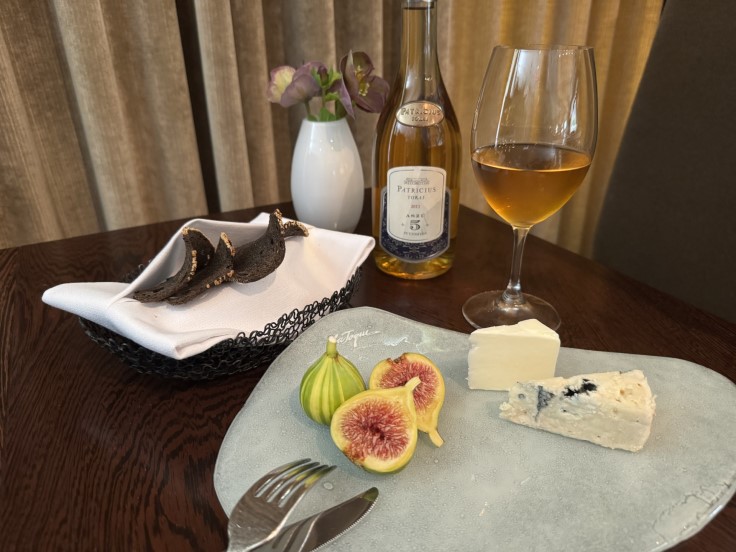
La Toque, Napa, California (*Add Sentence with keywords) (© Megan Menicucci)
The Village Pub, Woodside, CaliforniaJust south of San Francisco, The Village Pub, which has earned itself a MICHELIN Star for 12 consecutive years, specialises in contemporary Californian cuisine with French and Mediterranean roots. Around 80% of the restaurant’s ingredients are sourced from a 17-acre organic farm – SMIP Ranch – a few miles to the west in the Santa Cruz Mountains. In the mahogany dining room, diners tuck into ricotta gnudi with chanterelles à la Grecque, tender squash and golden raisins, and finish with a popular key lime tart, topped with toasted marshmallows, viola petals and meringue batons.
Selecting your drink could take some time here, as the wine list is 3,500 labels strong. If you’re in the mood for a sweet wine, however, skip straight to the Aszús. The Village Pub stocks four from the Royal Tokaji Wine Company and several bottles are marked as 6 Puttonyos – the highest traditional level of sweetness. Andrew Green, partner at Bacchus Management Group (BMG), which oversees The Village Pub, recalls discovering Aszú when a retailer in San Francisco imported small quantities of 6 puttonyos Tokaji – including some 1960s bottlings – from communist-era Hungary.
Aszú has starred on the restaurant’s extensive wine list for more than two decades, ever since the Royal Tokaji Wine Company presented its inaugural US release to the owners. Twenty years on, Bacchus has a proprietary single-barrel bottling in partnership with Royal Tokaji Wine Company – its current private barrel selection is the 2019 5 Puttonyos BMG Second Edition. Not only do the team meet with Estate Director Zoltán Kovács when he’s in town, but they have made the 10,000km trip to visit the winery in Mád. Jaime Pinedo, Wine and Beverage Director at BMG, considers the Royal Tokaji Wine Company to be “the class of the appellation” thanks to its origins. He explains: “Prior to the First World War, Tokaji was the preeminent tipple of European Aristocracy and the Royal Orders of the 18th and 19th centuries. Notable English wine author Hugh Johnson is credited with resuscitating the historic Royal Tokaji Wine Company after the fall of communism.”
What differentiates Aszú from other sweet wines? Jaime explains that the Tokaji Aszú shares several qualities with other botrytised dessert wines, most notably the aromas of saffron, desiccated citrus, ginger and sultanas. However, he believes the furmint grape is a more “neutral canvas” for noble rot than the grapes that produce many sauternes and pradikat rieslings. “In its youth, Aszú looks chartreuse green and has a nervy key lime verve,” he says. “With age, the acidity maintains a liveliness and it is one of the most versatile sweet wines to pair with cuisine. It complements citrus, berry and chocolate desserts, as well as cheese and charcuterie.”
Which vintages should oenophiles seek out? Jaime spotlights 2017 as the most recent vintage of note, and predicts that the 2021s will be highly sought after as they come to market. As the “O negative” of sweet wines, Azsú can be paired with a broad variety of cuisines, and every course on the meal, Jaime says. While typically, the restaurant would recommend Tokaji with cheese or its signature beignets with chocolate and crème anglaise, it has a place alongside savoury dishes too. “Pâté en croûte, kung pao Chicken and vadouvan curry all pair wonderfully,” Jaime says. “With dessert, tarte Tatin, baklava, mango chiffon Cake and even key lime pie.”
The Village Pub, Woodside, New York offers a great choice of Tokaji Aszú (© The Village Pub)
Other US Restaurants Serving Aszú on Their Wine List:
Main SelectionCasanova, California – European, Californian
Chez TJ, California – Contemporary
Crane Club, New York – Steakhouse
CUT, California – Steakhouse, American
Dio Deka, California – Greek, Mediterranean
Dubrovnik, New York – Croatian, Seafood
Element 47, Colorado – Contemporary
Fiola Mare, Washington DC – Seafood, Contemporary
Gary Danko, California – Contemporary
Genesis House Restaurant, New York – Korean Contemporary
Les Nomades, Chicago – French
Les Petites Canailles, California – French
Manhatta, New York – Contemporary American
Maple & Ash, Chicago – Steakhouse
Oceans, New York – Seafood, Contemporary
Pappas Bros. Steakhouse, Texas – Steakhouse, American
Pèppoli, California – Italian, American
RPM Steak, Chicago – Steakhouse, Contemporary
Rustic Canyon, California – Californian
1789, Washington DC – American, French
Sierra Mar, California – Californian, Contemporary
Signature Restaurant, Texas – American
Spruce, California – Californian, Contemporary
Sweet Basil, Colorado – Fusion
The Charter Oak, California – Californian
The Matheson, California – Contemporary
The Ranch, California – Steakhouse
The River Café, New York – Contemporary
The Sardine Factory, California – Seafood, American
The Stonehouse, California – American One Star Angler SF, California – Contemporary
Auberge du Soleil, California – Californian
Caruso’s, California – Californian, Italian
Clover Hill, New York – Contemporary Latin American
Cote, New York – Korean, Steakhouse
Cyrus, California – Californian, Modern
Essential by Christophe, New York – French Contemporary
Frasca Food and Wine, Colorado – Italian, Regional
Gramercy Tavern, New York – Contemporary, American
Hestia, Texas – Contemporary, American
Joo Ok, New York – Korean, Contemporary
L’Abeille, New York – French, Contemporary
Lazy Betty, Georgia – Contemporary
Localis, California – Californian, Contemporary
Nari, California – Thai, Contemporary
Nisei, California – Japanese, Contemporary
O’ by Claude Le Tohic, California – French, Contemporary
Protégé, California – Contemporary, Californian
Rania, Washington DC – Indian, Contemporary
Selby’s, California – American, Classic
The Surf Club Restaurant, Florida – AmericanTwo Stars Atera, New York – Contemporary
Aubergine, California – Contemporary, Californian
Blue Hill at Stone Barns, New York – Contemporary, American (Also Holds a Green Star)
Chef’s Table at Brooklyn Fare, New York – Contemporary
Gabriel Kreuther, New York – Contemporary, French
Oriole, Chicago – Contemporary, American
Saga, New York – Contemporary
Saison, California – Contemporary, Californian Three Stars Jungsik New York, New York – Korean, Contemporary
Per Se, New York – Contemporary, French
SingleThread, California – Contemporary, Californian (Also Holds a Green Star)
The French Laundry, California – Contemporary, French (Also Holds a Green Star)
The Inn at Little Washington, Washington DC – American, French (Also Holds a Green Star)
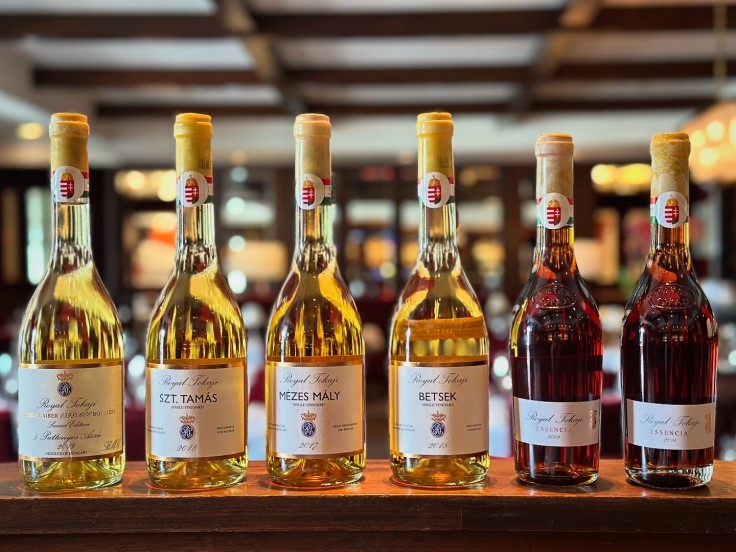
The wonderful colours of Tokaji Aszú (© The Village Pub)
UK, Channel Islands and Ireland
Ibai, LondonA visit to Ibai in the City of London means Basque cuisine with a strong French leaning enjoyed in chic industrial surroundings – glance over to the open kitchen to watch the chefs cooking quality ingredients over fire. In its well-stocked wine cellar, among its sizeable collection of French and Spanish vintages, Ibai keeps a few Hungarian bottles, including the Juliet Victor Tokaji Azsú 6 Puttonyos 2017. Ibai’s Wine Director Hugh Jones explains: “What I love most about the Juliet Victor 6 Puttonyos is the apricot jam, candied citrus peel marmalade, sweet spice and extremely long finish, with that backbone of acidity keeping the palate alive and ready for more.” He recommends the bottle with the Gateau Basque – one of the restaurant’s signature desserts. “Of course, it also works with a variety of dishes on our menu,” he says. “Personally, I love it with our cheese plate or foie gras pintxo.”
Elsewhere on the menu, the 3 Puttonyos Tokaji Aszú is an “unexpectedly brilliant match” with the restaurant’s signature Croque Ibai dish, which has previously proven tricky to pair. This decadent toasted sandwich is made on pan-fried cristal bread with carabinero prawns, boudin noir (French blood sausage) and tomme de brebis (an artisanal French cheese churned from ewe’s milk). It’s then topped with a drizzle of raw Pyrenean mountain honey and a sprinkle of espelette pepper. Meanwhile, the apricot jam and candied citrus notes of the Juliet Victor 6 Puttonyos complements every element of the Paté Basque, according to Hugh. This dish comprises a chunky mix of chicken liver, pork, confit duck gizzards and mushrooms, soaked in port and brandy, formed into a terrine, wrapped with Bayonne ham and finished with a liberal drizzle of truffle honey.
Hugh discovered Aszú early on in his career – it was his third day in the wine trade, in fact – while sampling a glass of the Royal Tokaji Company 5 Puttonyos at Majestic Wine back in 2007. “I was struck first by the orange marmalade, dried fruit and sweet spice notes,” he recalls, “but it was the balancing acidity of the Royal Tokaji 5 Puttonyos that really left a lasting impression.” Delighted with his first taste of Aszú, Hugh quickly splashed out on their 1993 Szt Tamas 6 Puttonyos, which “blew my mind and remains a favourite vintage”.
He explains that Tokaji Aszú is able to deliver the same complexity and ageability as other bottles in the category without being cloying thanks to its backbone of balancing acidity. And as one of his favourite sweet wines, showcasing Aszú on Ibai’s wine list was a no brainer. “For those who’ve tasted Aszú wines – they will always order if they see them on the list. For the uninitiated, giving a diner their first taste of Aszú is a joyful experience – to see their faces as the Aszú works its magic, it’s like re-living my own first experience with Tokaji through them,” he says.

The colours of the dish and the wine matching perfectly at Ibai, London (© Ibai)
Paul Ainsworth at No.6, Padstow, CornwallIn a whitewashed Georgian townhouse in Padstow, the One-MICHELIN-Starred Paul Ainsworth at No.6 showcases the chef’s considerable talents via creative and sometimes playful modern dishes. The kitchen harnesses the finest Cornish produce to whip up plates packed with flavour, including Pie ‘n’ Chips (made with Cornish moor beef), Stepper Point Lobster and hand-dived scallops from the Orkney Islands.
A haven for wine lovers, the restaurant boasts a lengthy wine list, curated by Liam Evans, Head Sommelier and Operations Director. There are also two wine pairing experiences available. For £125 per person, sample a pairing crafted to showcase lesser-known, unique grape-growing areas – from Dorset, England, to Otronia, Patagonia – and other rarer varieties. Alternatively, £175 per head will get you vintages from some of the world’s finest winemakers and most legendary regions, from Champagne in France and South Australia’s McLaren Vale to Tokaj in Hungary.
Upon discovering Aszú during his WSET studies, it was its history, region, unique qualities and winemaking that stood out to Liam. In later years, he discovered the Tokaj region made for great conversation with guests. While Liam’s first experience with Aszú was an “incredible” Royal Tokaji, No.6 currently lists Dobogo wines from Mád. “These really show the freshness and vibrancy that I enjoy so much in these wines,” he says. “Aszú wines are incredibly age-worthy, but I enjoy the freshness of more youthful wines; 2016 was fantastic for that, and we are currently pouring 2018 which is slightly more opulent.”
According to the sommelier, Aszú wines stand apart from other sweet bottles thanks to a balance of acidity and mineral freshness: specifically the combination of rich, sweet, citrus and stone fruit flavours against spice, complex botrytis notes and furmint’s vibrant acidity. “It is an incredibly versatile wine and can be paired with a wide range of dishes,” Liam says. “As a restaurant our menu style is all about flavour, so wines such as Aszú that are complex and rich make great pairings.” Indeed, at No.6 these pairings have included bird’s liver, smoked eel and carrot ketchup, as well as roasted veal sweetbreads, pearl barley and yuzu. “The salty richness of the sweetbreads against the sweetness of the Aszú and the freshness of yuzu with furmint’s bright acidity works so well,” Liam says.

Cheese and Aszú at Paul Ainsworth, Padstow, Cornwall (© Adam Sargent Photography)
Pêtchi, St Helier, Jersey, Channel IslandsFresh Channel Islands ingredients meet Basque cooking techniques at the buzzing Pêtchi in Jersey. The restaurant’s simple, rustic décor places the focus firmly on the open kitchen, where you can glimpse a wood-fired oven and glowing coals. Wine – overseen by Manager and Sommelier Sophie Clarke – is a big deal here. As she explains, there are several reasons why a “remarkably fresh” 2017 Hungarian Royal Tokaji 5 Puttonyos ‘Blue Label’ landed on the restaurant’s sweet wine list. “It’s a complete icon, really versatile with food, and from one of the oldest wine regions in the world,” she said. “Our Head Chef Tamas is also Hungarian, so it’s a nice nod to the wines of his homeland.”
Sophie highlights the fascinating traditions, history and language surrounding Hungarian wines. Learning about these bottles during her wine course, she was drawn to the ethos of using every berry in one way or another, and intrigued by the puttonyos scale, which corresponds to the number of buckets of rotten berries emptied into each barrel. “It’s hard to believe something so decadent is created from something so rotten,” she says. “As a lifelong sweet tooth, the rich, nutty, marmalade decadence in a glass is pure heaven to me.”
Joseph Baker, Pêtchi’s chef-owner, explains the appeal of Aszú from the kitchen’s perspective. “Just like with food, it starts with a great product,” he says. “The use of a portion of grapes with noble rot adds complexity, and the naturally high acidity in grape varieties like furmint lends the wine a balance that is really important for me.”
In terms of pairings, there are a lot of options. Pêtchi previously created a dessert which used the wine as part of a smoked milk custard filling inside a caramelised crêpe. However, Joseph notes that the wine pairs very nicely with savoury dishes too. One example is their pairing with a dish of venison loin, grilled apples and sweetcorn in smoked honey butter. “The sweetness and minerality of the wine really complements the caramelised notes of the apples,” he explains. “Then the smokiness that runs through the dish – from the oak over which we cook the venison and the smoked butter – is offset beautifully by the wine’s complex fruitiness. These highly seasoned, umami-packed elements of the dish benefit from the wine’s sweetness to offset them.”
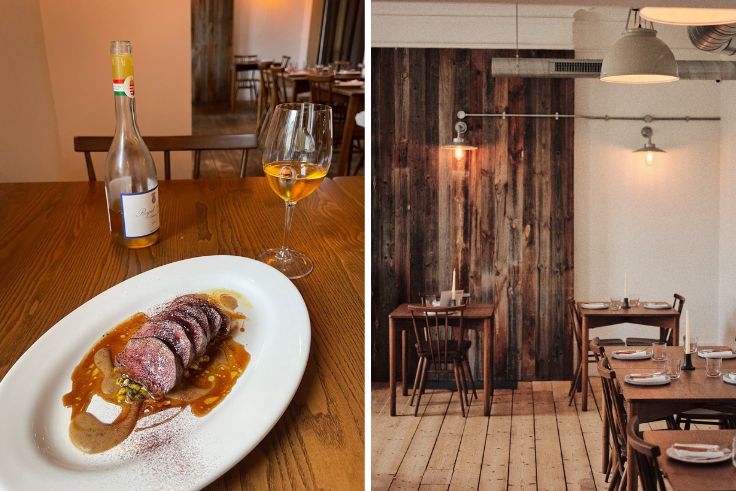
Tokaji Aszú accompanying a main course at Pêtchi, St Helier, Jersey, Channel Islands (© Pêtchi)
Other Restaurants in the UK and Ireland Serving Aszú on Their Wine List:
Main SelectionBob Bob Ricard City, London – French
Cabotte, London – French
Canton Blue, London – Cantonese
City Social, London – Modern / Classic
Clos Maggiore, London – French
Ekstedt at the Yard, London – Modern
45 Jermyn St, London – Traditional British
Franco’s, London – Italian
George V, Cong, Ireland – Classic
J. Sheekey, London – Seafood
Kerridge’s Bar and Grill, London – Modern British
Les 110 de Taillevent, London – French
Montagu’s Mews, Bath – Modern
Noble Rot, London – Classic French
Sael, London – Modern British
Sir Charles Napier, Chinnor – Modern British
The Cocochine, London – Modern French
The Grill (Dorchester), London – British Contemporary
The Vineyard, Newbury – Modern
The Woodspeen, Newbury – Modern
Wild Tavern, London – Italian Bib GourmandsArdfern, Leith – International
Upstairs at Trinity, London – ModernGreen StarHenry Robertson, Llandderfel, Wales – Modern British One StarAdam’s, Birmingham – Modern
Allium at Askham Hall, Askham – Modern British
Ballyfin, Ballyfin – Modern
Chez Bruce, London – French
Dining Room at The Goring, London – Traditional British
Dysart Petersham, London – Modern
1890 by Gordon Ramsay, London – French Contemporary
Harwood Arms, London – Modern British
HIDE, London – Modern British
KOL, London – Modern Mexican
La Trompette, London – Modern British
Luca, London – Italian
Mauro Colagreco at Raffles London at The OWO, London – Modern
Northcote, Langho – Modern British
Olive Tree, Bath – Modern
Ormer Mayfair, London – Modern British
The Dining Room (Whatley Manor), Malmesbury – Creative
The Samling, Ambleside – Modern
Trinity, London – Modern Two StarsAlex Dilling at Hotel Café Royal, London – Modern French
Dinner by Heston Blumenthal, London – Traditional British
Patrick Guilbaud, Dublin – Modern French
Restaurant Andrew Fairlie, Auchterarder – Modern French
Trivet, London – Modern
Ynyshir, Machynlleth, Wales – Creative Three StarsAlain Ducasse at The Dorchester, London – French
CORE by Clare Smyth, London – Modern British
Hélène Darroze at the Connaught, London – Modern
Moor Hall, Aughton – Modern British (Also Holds a Green Star)
Restaurant Gordon Ramsay, London – French
The Ledbury, London – Modern

Bottles of Aszú in the cellar at Paul Ainsworth at No.6 (© Adam Sargent Photography)
Trying Tokaji Aszú If you don’t have a trip to Hungary’s ancient Tokaj wine country on the horizon, you don’t have to miss out – locating Tokaji Aszú in the US or the UK is no longer difficult; you only need to know to look out for it and you’ll notice it more and more. It’s no longer the reserve of the ‘elite’ either – you’ll find it on the wine lists of all manner of restaurants, from American and British to French and Mexican, from robust steakhouses to chic, elegant spots.
As demonstrated above, many of the sommeliers and restaurant teams who stock Tokaji Aszú are particularly passionate and knowledgeable about this wine – sampling a glass is the only way to find out why!
Hero Image: A Hungarian Tokaji Aszú accompanying an apple dessert at MICHELIN-Starred Paul Ainsworth at No.6 in Padstow, Cornwall, UK (© Paul Sargent Photography)

Written by
Caroline Howley
Caroline is a MICHELIN Guide contributor. A Manchester-based travel writer, she has spent the past 15 years exploring the diverse landscapes, cuisines and cultures of Europe and Asia. Driven by a passion for outstanding hospitality and culture shocks, her writing has taken her from Hungary and Lithuania to Vietnam and Laos, as well as many places in between.

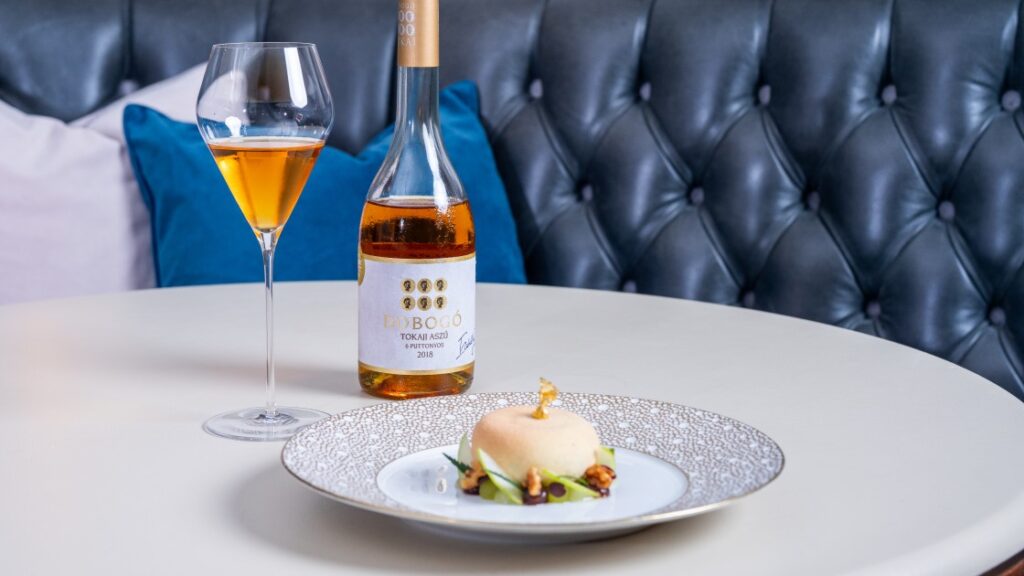
Dining and Cooking